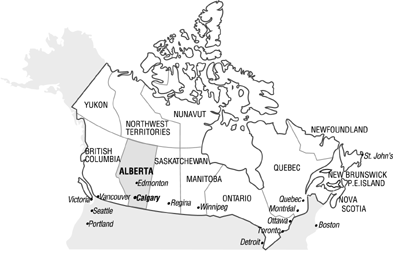Canada

Canada, arching atop North America, is the second largest country in the world and a land of diversity both in its natural and in its human resources. Its east-west extent sprawls 5,187 km and is so wide that it spans six time zones within its borders. Its population is over 29 million, about 80 per cent of whom live within 160 km of the U.S. border. Huge tracts of uninhabited northern forests and vast tundras result in Canada having one of the lowest population densities in the world.
The name Canada is thought to have come from Kanata, the Huron-Iroquois word meaning village or community.
Canada Quick Facts
- Land Area: 9,970,610 km2
- Capital: Ottawa
- Largest City: Toronto
- Highest Mountain: Mount Logan, 6,050 m
- Population: 29,413,100 (1995)
- Official Languages: English, French
- Principal Trade Partners: U.S.A., Japan, United Kingdom
- Currency: 1 dollar = 100 cents
- Political Subdivisions: 10 provinces, 3 territories
- Government:
- Federal/Provincial
- 1 Prime Minister, 10 Premiers
- Parliament/Legislature
- Post-Secondary Institutions: 284
Canada has two official languages, English and French, which have equal status in affairs of the federal and provincial governments and federal courts. Reflecting the dual cultural heritage, Canada has developed a strong literary tradition in both languages. Canada has no official religion, however, the largest religious denomination is Roman Catholic with about 46% of the population adhering to that faith. The ethnic composition of the population today is a result of successive waves of immigration. Canada is proud of its multiculturalism, being a nation forged by immigrants.
The character of its people is more identifiable by region rather than by the culture as a whole. Ottawa, institutionally gracious, may be Canadaßs capital but itßs not cut from the same national fabric as Newfoundland, with its sturdy, seafaring practicality, or Montreal‹vibrant, French, original‹or British Columbia, an amalgam of picturesque mountain scenes and oceanside cities blending British quaintness with Pacific muscle, or Alberta, with its western frontier flavour mixed with the high-power stakes of the oil and gas business.
Without question Western Canada is one of the most spectacular regions in North America. The provinces of British Columbia, Alberta and Saskatchewan offer a rich tapestry of exciting landscapes including the craggy mountains of the Canadian Rockies, the seacoast of the Pacific Ocean, stretches of golden prairie, wild rivers, serene lakes, cosmopolitan cities, small rural towns, and deserts filled with the bones of dinosaurs.
Western Canada has colourful historical roots that has left a legacy of the rough and tumble west, the gold rush and the railway. Approximately seven and a half million people from a diversity of cultural backgrounds are proud to call themselves Western Canadians.

Return to Where table of contents.

